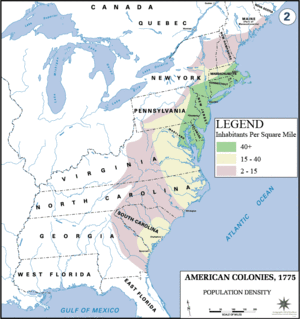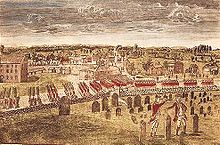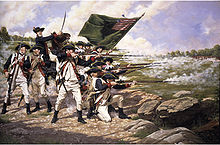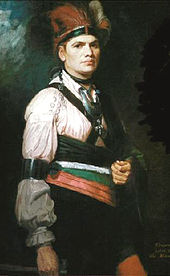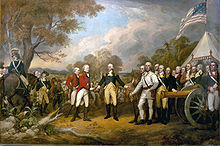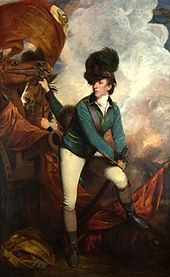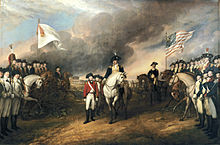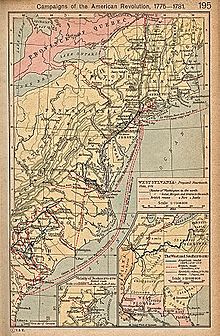
American Revolutionary War
Background Information
SOS Children, which runs nearly 200 sos schools in the developing world, organised this selection. Click here for more information on SOS Children.
| American Revolutionary War | |||||||||
|---|---|---|---|---|---|---|---|---|---|
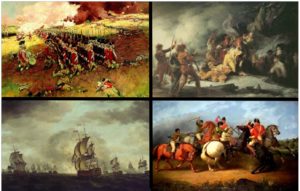 Clockwise from top left: Battle of Bunker Hill, Death of Montgomery at Quebec, Battle of Cowpens, "Moonlight Battle" |
|||||||||
|
|||||||||
| Belligerents | |||||||||
Co-belligerents: |
Co-belligerents |
||||||||
| Commanders and leaders | |||||||||
...full list |
Joseph Brant ...full list |
||||||||
| Strength | |||||||||
| At Height: 35,000 Continentals |
At Height: 56,000 British |
||||||||
| Casualties and losses | |||||||||
American: 25,000 dead
Total American casualties: up to 50,000 dead and wounded |
20,000± Soldiers from the British army dead and wounded 19,740 sailors dead (1,240 in Battle) |
||||||||
|
|||||
The American Revolutionary War (1775–1783), the American War of Independence, or simply the Revolutionary War in the United States, began as a war between the Kingdom of Great Britain and the Thirteen Colonies, but gradually grew into a world war between Britain on one side and the newly formed United States, France, Netherlands and Spain on the other. The main result was an American victory and European recognition of the independence of the United States, with mixed results for the other powers.
The war was the result of the political American Revolution. Colonists galvanized around the position that the Stamp Act of 1765, imposed by Parliament of Great Britain, was unconstitutional. The British Parliament insisted it had the right to tax colonists to finance the colonies' military defense, which had become increasingly expensive due to the French and Indian Wars. The colonists claimed that, as they were British subjects, taxation without representation in Parliament was illegal. The American colonists formed a unifying Continental Congress and a shadow government in each colony.
The American boycott of taxed British tea led to the Boston Tea Party in 1773, when shiploads of tea were destroyed. London responded by ending self-government in Massachusetts and putting it under the control of the British army with General Thomas Gage as governor. In April 1775 Gage learned that weapons were being gathered in Concord, and he sent British troops to seize and destroy them. Local militia confronted the troops and exchanged fire (see Battles of Lexington and Concord).
After repeated pleas to the British monarchy for intervention with Parliament, any chance of a compromise ended when the Congress were declared traitors by royal decree, and they responded by declaring the independence of a new sovereign nation, the United States of America, on July 4, 1776. American Loyalists rejected the Declaration, and sided with the king; they were excluded from power everywhere. American attempts to expand the rebellion into Quebec and the Floridas were unsuccessful.
France, Spain and the Dutch Republic all secretly provided supplies, ammunition and weapons to the revolutionaries starting early in 1776. By June 1776 the Americans were in full control of every state, but then the British Royal Navy captured New York City and made it their main base. The war became a standoff. The Royal Navy could occupy other coastal cities for brief periods, but the rebels controlled the countryside, where 90 percent of the population lived. British strategy relied on mobilizing Loyalist militia and was never fully realized. A British invasion from Canada in 1777 ended in the capture of the British army at the Battles of Saratoga.
That American victory persuaded France to enter the war openly in early 1778, balancing the two sides' military strength. Spain and the Dutch Republic—French allies—also went to war with Britain over the next four years, threatening an invasion of Great Britain and severely testing British military strength with campaigns in Europe, Asia, and the Caribbean. Spain's involvement resulted in the expulsion of British armies from West Florida, securing the American southern flank. The British naval victory at the Battle of the Saintes thwarted a French and Spanish plan to drive Britain out of the Caribbean and preparations for a second attempt were halted by the declaration of peace. A long Franco-Spanish siege of the British stronghold at Gibraltar also resulted in defeat.
French involvement proved decisive yet expensive, ruining France's economy and driving the country into massive debt. A French naval victory just outside Chesapeake Bay led to a siege by combined French and Continental armies that forced a second British army to surrender at Yorktown, Virginia in 1781. Fighting continued throughout 1782, while peace negotiations began.
In 1783, the Treaty of Paris ended the war and recognized the sovereignty of the United States over the territory bounded roughly by what is now Canada to the north, Florida to the south, and the Mississippi River to the west. A wider international peace was agreed, in which several territories were exchanged.
Combatants before 1778
American armies and militias
When the war began, the 13 colonies lacked a professional army or navy. Each colony sponsored local militia. Militiamen were lightly armed, had little training, and usually did not have uniforms. Their units served for only a few weeks or months at a time, were reluctant to travel far from home and thus were unavailable for extended operations, and lacked the training and discipline of soldiers with more experience. If properly used, however, their numbers could help the Continental armies overwhelm smaller British forces, as at the battles of Concord, Bennington and Saratoga, and the siege of Boston. Both sides used partisan warfare but the Americans effectively suppressed Loyalist activity when British regulars were not in the area.
Seeking to coordinate military efforts, the Continental Congress established (on paper) a regular army on June 14, 1775, and appointed George Washington as commander-in-chief. The development of the Continental Army was always a work in progress, and Washington used both his regulars and state militia throughout the war.
The United States Marine Corps traces its institutional roots to the Continental Marines of the war, formed at Tun Tavern in Philadelphia, by a resolution of the Continental Congress on November 10, 1775, a date regarded and celebrated as the birthday of the Marine Corps. At the beginning of 1776, Washington's army had 20,000 men, with two-thirds enlisted in the Continental Army and the other third in the various state militias. At the end of the American Revolution in 1783, both the Continental Navy and Continental Marines were disbanded. About 250,000 men served as regulars or as militiamen for the Revolutionary cause in the eight years of the war, but there were never more than 90,000 men under arms at one time.
Armies were small by European standards of the era, largely attributable to limitations such as lack of powder and other logistical capabilities on the American side. It was also difficult for Great Britain to transport troops across the Atlantic and they depended on local supplies that the Patriots tried to cut off. By comparison, Duffy notes that Frederick the Great usually commanded from 23,000 to 50,000 in battle. Both figures pale in comparison to the armies that would be fielded in the early 19th century, where troop formations approached or exceeded 100,000 men.
Loyalists
Historians have estimated that approximately 40 to 45 percent of the colonists supported the rebellion, while 15 to 20 percent remained loyal to the Crown. The rest attempted to remain neutral and kept a low profile.
At least 25,000 Loyalists fought on the side of the British. Thousands served in the Royal Navy. On land, Loyalist forces fought alongside the British in most battles in North America. Many Loyalists fought in partisan units, especially in the Southern theatre.
The British military met with many difficulties in maximizing the use of Loyalist factions. British historian Jeremy Black wrote, "In the American war it was clear to both royal generals and revolutionaries that organized and significant Loyalist activity would require the presence of British forces." In the South, the use of Loyalists presented the British with "major problems of strategic choice" since while it was necessary to widely disperse troops in order to defend Loyalist areas, it was also recognized that there was a need for "the maintenance of large concentrated forces able" to counter major attacks from the American forces. In addition, the British were forced to ensure that their military actions would not "offend Loyalist opinion", eliminating such options as attempting to "live off the country", destroying property for intimidation purposes, or coercing payments from colonists ("laying them under contribution").
British armies and auxiliaries
Early in 1775, the British Army consisted of about 36,000 men worldwide, but wartime recruitment steadily increased this number. Great Britain had a difficult time appointing general officers, however. General Thomas Gage, in command of British forces in North America when the rebellion started, was criticized for being too lenient (perhaps influenced by his American wife). General Jeffrey Amherst, 1st Baron Amherst turned down an appointment as commander in chief due to an unwillingness to take sides in the conflict. Similarly, Admiral Augustus Keppel turned down a command, saying "I cannot draw the sword in such a cause." The Earl of Effingham publicly resigned his commission when his 22nd Regiment of foot was posted to America, and William Howe and John Burgoyne were members of parliament who opposed military solutions to the American rebellion. Howe and Henry Clinton stated that they were unwilling participants in the war and were only following orders.
Over the course of the war, Great Britain signed treaties with various German states, which supplied about 30,000 soldiers. Germans made up about one-third of the British troop strength in North America. The Landgraviate of Hesse-Kassel contributed more soldiers than any other state, and German soldiers became known as " Hessians" to the Americans. Revolutionary speakers called German soldiers "foreign mercenaries," and they are scorned as such in the Declaration of Independence. By 1779, the number of British and German troops stationed in North America was over 60,000, although these were spread from Canada to Florida. Initially, several German principalities offered military support to Great Britain but these offers were rejected. However, as the war dragged on it became clear that Great Britain would need the extra manpower of the German states and led to Great Britain seeking support from German principalities such as Hesse-Kassel and Ansbach-Bayreuth.
The Secretary of State at War Lord Barrington and the Adjutant-General Edward Harvey were both strongly opposed to outright war on land. In 1766 Barrington had recommended withdrawing the army from the 13 Colonies to Canada, Nova Scotia and Florida. At the beginning of the war he urged a naval blockade, which would quickly damage the colonists' trading activities.
Black Americans
African Americans—slave and free—served on both sides during the war. The British recruited slaves belonging to Patriot masters and promised freedom to those who served by act of Lord Dunmore's Proclamation. Because of manpower shortages, George Washington lifted the ban on black enlistment in the Continental Army in January 1776. Small all-black units were formed in Rhode Island and Massachusetts; many slaves were promised freedom for serving. Another all-black unit came from Haiti with French forces. At least 5,000 black soldiers fought for the Revolutionary cause.
Tens of thousands of slaves escaped during the war and joined British lines; others simply moved off into the chaos. For instance, in South Carolina, nearly 25,000 slaves (30% of the enslaved population) fled, migrated or died during the disruption of the war. This greatly disrupted plantation production during and after the war. When they withdrew their forces from Savannah and Charleston, the British also evacuated 10,000 slaves, now freedmen. Altogether, the British were estimated to evacuate nearly 20,000 freedmen (including families) with other Loyalists and their troops at the end of the war. More than 3,000 freedmen were resettled in Nova Scotia; others were transported to the West Indies of the Caribbean islands, and some to Great Britain.
Native Americans
Most Native Americans east of the Mississippi River were affected by the war, and many communities were divided over the question of how to respond to the conflict. Though a few tribes were on friendly terms with the Americans, most Native Americans opposed the United States as a potential threat to their territory. Approximately 13,000 Native Americans fought on the British side, with the largest group coming from the Iroquois tribes, who fielded around 1,500 men. The powerful Iroquois Confederacy was shattered as a result of the conflict; although the Confederacy did not take sides, the Seneca, Onondaga, and Cayuga nations sided with the British. Members of the Mohawk fought on both sides. Many Tuscarora and Oneida sided with the colonists. The Continental Army sent the Sullivan Expedition on raids throughout New York to cripple the Iroquois tribes which had sided with the British. Both during and after the war friction between the Mohawk leaders Joseph Louis Cook and Joseph Brant, who had sided with the Americans and the British respectively, further exacerbated the split.
Creek and Seminole allies of Britain fought against Americans in Georgia and South Carolina. In 1778, a force of 800 Creeks destroyed American settlements along the Broad River in Georgia. Creek warriors also joined Thomas Brown's raids into South Carolina and assisted Britain during the Siege of Savannah. Many Native Americans were involved in the fighting between Britain and Spain on the Gulf Coast and up the Mississippi River—mostly on the British side. Thousands of Creeks, Chickasaws, and Choctaws fought in or near major battles such as the Battle of Fort Charlotte, the Battle of Mobile, and the Siege of Pensacola.
Sex, race, class
Pybus (2005) estimates that about 20,000 slaves defected to or were captured by the British, of whom about 8,000 died from disease or wounds or were recaptured by the Patriots, and 12,000 left the country at the end of the war, for freedom in Canada or slavery in the West Indies.
Baller (2006) examines family dynamics and mobilization for the Revolution in central Massachusetts. He reports that warfare and the farming culture were sometimes incompatible. Militiamen found that living and working on the family farm had not prepared them for wartime marches and the rigors of camp life. Rugged individualism conflicted with military discipline and regimentation. A man's birth order often influenced his military recruitment, as younger sons went to war and older sons took charge of the farm. A person's family responsibilities and the prevalent patriarchy could impede mobilization. Harvesting duties and family emergencies pulled men home regardless of the sergeant's orders. Some relatives might be Loyalists, creating internal strains. On the whole, historians conclude the Revolution's effect on patriarchy and inheritance patterns favored egalitarianism.
McDonnell, (2006) shows a grave complication in Virginia's mobilization of troops was the conflicting interests of distinct social classes, which tended to undercut a unified commitment to the Patriot cause. The Assembly balanced the competing demands of elite slave owning planters, the middling yeomen (some owning a few slaves), and landless indentured servants, among other groups. The Assembly used deferments, taxes, military service substitute, and conscription to resolve the tensions. Unresolved class conflict, however, made these laws less effective. There were violent protests, many cases of evasion, and large-scale desertion, so that Virginia's contributions came at embarrassingly low levels. With the British invasion of the state in 1781, Virginia was mired in class division as its native son, George Washington, made desperate appeals for troops.
War in the north, 1775–1780
Massachusetts
Before the war, Boston had been the centre of much revolutionary activity, leading to the punitive Massachusetts Government Act in 1774 that ended local government. Popular resistance to these measures, however, compelled the newly appointed royal officials in Massachusetts to resign or to seek refuge in Boston. Lieutenant General Thomas Gage, the British North American commander-in chief, commanded four regiments of British regulars (about 4,000 men) from his headquarters in Boston, but the countryside was in the hands of the Revolutionaries.
On the night of April 18, 1775, General Gage sent 700 men to seize munitions stored by the colonial militia at Concord, Massachusetts. Riders including Paul Revere alerted the countryside, and when British troops entered Lexington on the morning of April 19, they found 77 minutemen formed up on the village green. Shots were exchanged, killing several minutemen. The British moved on to Concord, where a detachment of three companies was engaged and routed at the North Bridge by a force of 500 minutemen. As the British retreated back to Boston, thousands of militiamen attacked them along the roads, inflicting great damage before timely British reinforcements prevented a total disaster. With the Battles of Lexington and Concord, the war had begun.
The militia converged on Boston, bottling up the British in the city. About 4,500 more British soldiers arrived by sea, and on June 17, 1775, British forces under General William Howe seized the Charlestown peninsula at the Battle of Bunker Hill. The Americans fell back, but British losses were so heavy that the attack was not followed up. The siege was not broken, and Gage was soon replaced by Howe as the British commander-in-chief.
In July 1775, newly appointed General Washington arrived outside Boston to take charge of the colonial forces and to organize the Continental Army. Realizing his army's desperate shortage of gunpowder, Washington asked for new sources. Arsenals were raided and some manufacturing was attempted; 90% of the supply (2 million pounds) was imported by the end of 1776, mostly from France. Patriots in New Hampshire had seized powder, muskets and cannons from Fort William and Mary in Portsmouth Harbour in late 1774. Some of the munitions were used in the Boston campaign.
The standoff continued throughout the fall and winter. In early March 1776, heavy cannons that the patriots had captured at Fort Ticonderoga were brought to Boston by Colonel Henry Knox, and placed on Dorchester Heights. Since the artillery now overlooked the British positions, Howe's situation was untenable, and the British fled on March 17, 1776, sailing to their naval base at Halifax, Nova Scotia. Washington then moved most of the Continental Army to fortify New York City.
Quebec
Three weeks after the siege of Boston began, a troop of militia volunteers led by Ethan Allen and Benedict Arnold captured Fort Ticonderoga, a strategically important point on Lake Champlain between New York and the Province of Quebec. After that action they also raided Fort St. John's, not far from Montreal, which alarmed the population and the authorities there. In response, Quebec's governor Guy Carleton began fortifying St. John's, and opened negotiations with the Iroquois and other Native American tribes for their support. These actions, combined with lobbying by both Allen and Arnold and the fear of a British attack from the north, eventually persuaded the Congress to authorize an invasion of Quebec, with the goal of driving the British military from that province. (Quebec was then frequently referred to as Canada, as most of its territory included the former French Province of Canada.)
Two Quebec-bound expeditions were undertaken. On September 28, 1775, Brigadier General Richard Montgomery marched north from Fort Ticonderoga with about 1,700 militiamen, besieging and capturing Fort St. Jean on November 2 and then Montreal on November 13. General Carleton escaped to Quebec City and began preparing that city for an attack. The second expedition, led by Colonel Arnold, went through the wilderness of what is now northern Maine. Logistics were difficult, with 300 men turning back, and another 200 perishing due to the harsh conditions. By the time Arnold reached Quebec City in early November, he had but 600 of his original 1,100 men. Montgomery's force joined Arnold's, and they attacked Quebec City on December 31, but were defeated by Carleton in a battle that ended with Montgomery dead, Arnold wounded, and over 400 Americans taken prisoner. The remaining Americans held on outside Quebec City until the spring of 1776, suffering from poor camp conditions and smallpox, and then withdrew when a squadron of British ships under Captain Charles Douglas arrived to relieve the siege.
Another attempt was made by the Americans to push back towards Quebec, but they failed at Trois-Rivières on June 8, 1776. Carleton then launched his own invasion and defeated Arnold at the Battle of Valcour Island in October. Arnold fell back to Fort Ticonderoga, where the invasion had begun. While the invasion ended as a disaster for the Americans, Arnold's efforts in 1776 delayed a full-scale British counteroffensive until the Saratoga campaign of 1777.
The invasion cost the Americans their base of support in British public opinion, "So that the violent measures towards America are freely adopted and countenanced by a majority of individuals of all ranks, professions, or occupations, in this country." It gained them at best limited support in the population of Quebec, which, while somewhat supportive early in the invasion, became less so later during the occupation, when American policies against suspected Loyalists became harsher, and the army's hard currency ran out. Two small regiments of Canadiens were recruited during the operation, and they were with the army on its retreat back to Ticonderoga.
New York and New Jersey
Having withdrawn his army from Boston, General Howe now focused on capturing New York City, which then was limited to the southern tip of Manhattan Island. To defend the city, General Washington spread about 20,000 soldiers along the shores of New York's harbour, concentrated on Long Island and Manhattan. While British and recently hired Hessian troops were assembling across the upper harbour on Staten Island for the campaign, Washington had the newly issued Declaration of American Independence read to his men and the citizens of the city. No longer was there any possibility of compromise. On August 27, 1776, after landing about 22,000 men on Long Island, the British drove the Americans back to Brooklyn Heights, securing a decisive British victory in the largest battle of the entire Revolution. Howe then laid siege to fortifications there. In a feat considered by many military historians to be one of his most impressive actions as Commander in Chief, Washington personally directed the withdrawal of his entire remaining army and all their supplies across the East River in one night without discovery by the British or significant loss of men and materiel.
After a failed peace conference on September 11, Howe resumed the attack. On September 15, Howe landed about 12,000 men on lower Manhattan, quickly taking control of New York City. The Americans withdrew north up the island to Harlem Heights, where they skirmished the next day but held their ground. When Howe moved to encircle Washington's army in October, the Americans again fell back, and a battle at White Plains was fought on October 28. Again Washington retreated, and Howe returned to Manhattan and captured Fort Washington in mid November, taking about 2,000 prisoners (with an additional 1,000 having been captured during the battle for Long Island). Thus began the infamous "prison ships" system the British maintained in New York for the rest of the war, in which more American soldiers and sailors died of neglect than died in every battle of the entire war, combined.
Howe then detached General Clinton to seize Newport, Rhode Island, while General Lord Cornwallis continued to chase Washington's army through New Jersey, until the Americans withdrew across the Delaware River into Pennsylvania in early December. With the campaign at an apparent conclusion for the season, the British entered winter quarters. Although Howe had missed several opportunities to crush the diminishing American army, he had killed or captured over 5,000 Americans.
The outlook of the Continental Army was bleak. "These are the times that try men's souls," wrote Thomas Paine, who was with the army on the retreat. The army had dwindled to fewer than 5,000 men fit for duty, and would be reduced to 1,400 after enlistments expired at the end of the year. Congress had abandoned Philadelphia in despair, although popular resistance to British occupation was growing in the countryside.
Washington decided to take the offensive, stealthily crossing the Delaware on Christmas night and capturing nearly 1,000 Hessians at the Battle of Trenton on December 26, 1776. Cornwallis marched to retake Trenton but was first repulsed and then outmaneuvered by Washington, who successfully attacked the British rearguard at Princeton on January 3, 1777. Washington then entered winter quarters at Morristown, New Jersey, having given a morale boost to the American cause. New Jersey militia continued to harass British and Hessian forces throughout the winter, forcing the British to retreat to their base in and around New York City.
At every stage the British strategy assumed a large base of Loyalist supporters would rally to the King given some military support. In February 1776 Clinton took 2,000 men and a naval squadron to invade North Carolina, which he called off when he learned the Loyalists had been crushed at the Battle of Moore's Creek Bridge. In June he tried to seize Charleston, South Carolina, the leading port in the South, hoping for a simultaneous rising in South Carolina. It seemed a cheap way of waging the war but it failed as the naval force was defeated by the forts and because no local Loyalists attacked the town from behind. The Loyalists were too poorly organized to be effective, but as late as 1781 senior officials in London, misled by Loyalist exiles, placed their confidence in their rising.
Saratoga and Philadelphia

When the British began to plan operations for 1777, they had two main armies in North America: Carleton's army in Quebec, and Howe's army in New York. In London, Lord George Germain approved campaigns for these armies which, because of miscommunication, poor planning, and rivalries between commanders, did not work in conjunction. Although Howe successfully captured Philadelphia, the northern army was lost in a disastrous surrender at Saratoga. Both Carleton and Howe resigned after the 1777 campaign.
Saratoga campaign
The first of the 1777 campaigns was an expedition from Quebec led by General John Burgoyne. The goal was to seize the Lake Champlain and Hudson River corridor, effectively isolating New England from the rest of the American colonies. Burgoyne's invasion had two components: he would lead about 8,000 men along Lake Champlain towards Albany, New York, while a second column of about 2,000 men, led by Barry St. Leger, would move down the Mohawk River Valley and link up with Burgoyne in Albany.
Burgoyne set off in June, and recaptured Fort Ticonderoga in early July. Thereafter, his march was slowed by the Americans who literally knocked down trees in his path, and by his army's extensive baggage train. A detachment sent out to seize supplies was decisively defeated in the Battle of Bennington by American militia in August, depriving Burgoyne of nearly 1,000 men.
Meanwhile, St. Leger—more than half of his force Native Americans led by Sayenqueraghta—had laid siege to Fort Stanwix. American militiamen and their Native American allies marched to relieve the siege but were ambushed and scattered at the Battle of Oriskany. When a second relief expedition approached, this time led by Benedict Arnold, St. Leger's Indian support abandoned him, forcing him to break off the siege and return to Quebec.
Burgoyne's army had been reduced to about 6,000 men by the loss at Bennington and the need to garrison Ticonderoga, and he was running short on supplies. Despite these setbacks, he determined to push on towards Albany. An American army of 8,000 men, commanded by General Horatio Gates, had entrenched about 10 miles (16 km) south of Saratoga, New York. Burgoyne tried to outflank the Americans but was checked at the first battle of Saratoga in September. Burgoyne's situation was desperate, but he now hoped that help from Howe's army in New York City might be on the way. It was not: Howe had instead sailed away on his expedition to capture Philadelphia. American militiamen flocked to Gates' army, swelling his force to 11,000 by the beginning of October. After being badly beaten at the second battle of Saratoga, Burgoyne surrendered on October 17.
Saratoga was the turning point of the war. Revolutionary confidence and determination, suffering from Howe's successful occupation of Philadelphia, was renewed. What is more important, the victory encouraged France to make an open alliance with the Americans, after two years of semi-secret support. For the British, the war had now become much more complicated.
Philadelphia campaign
Having secured New York City in 1776, General Howe concentrated on capturing Philadelphia, the seat of the Revolutionary government, in 1777. He moved slowly, landing 15,000 troops in late August at the northern end of Chesapeake Bay. Washington positioned his 11,000 men between Howe and Philadelphia but was driven back at the Battle of Brandywine on September 11, 1777. The Continental Congress again abandoned Philadelphia, and on September 26, Howe finally outmaneuvered Washington and marched into the city unopposed. Washington unsuccessfully attacked the British encampment in nearby Germantown in early October and then retreated to watch and wait.
After repelling a British attack at White Marsh, Washington and his army encamped at Valley Forge in December 1777, about 20 miles (32 km) from Philadelphia, where they stayed for the next six months. Over the winter, 2,500 men (out of 10,000) died from disease and exposure. The next spring, however, the army emerged from Valley Forge in good order, thanks in part to a training program supervised by Baron von Steuben, who introduced the most modern Prussian methods of organization and tactics.
General Clinton replaced Howe as British commander-in-chief. French entry into the war had changed British strategy, and Clinton abandoned Philadelphia to reinforce New York City, now vulnerable to French naval power. Washington shadowed Clinton on his withdrawal and forced a strategic victory at the battle at Monmouth on June 28, 1778, the last major battle in the north. Clinton's army went to New York City in July, arriving just before a French fleet under Admiral d'Estaing arrived off the American coast. Washington's army returned to White Plains, New York, north of the city. Although both armies were back where they had been two years earlier, the nature of the war had now changed.
An international war, 1778–1783
From 1776 France had informally been involved in the American Revolutionary War, with French admiral Latouche Tréville having provided supplies, ammunition and guns from France to the United States after Thomas Jefferson had encouraged a French alliance, and guns such as de Valliere type were used, playing an important role in such battles as the Battle of Saratoga. George Washington wrote about the French supplies and guns in a letter to General Heath on May 2, 1777. After learning of the American victory at Saratoga, France signed the Treaty of Alliance with the United States on February 6, 1778, formalizing the Franco-American alliance negotiated by Benjamin Franklin.
In 1776 the Count of Aranda met in representation of Spain with the first U.S. Commission composed by Benjamin Franklin, Silas Deane and Arthur Lee. The Continental Congress had charged the commissioners to travel to Europe and forge alliances with other European powers that could help break the British naval blockade along the North American coast. Aranda invited the commission to his house in Paris, where he was acting as Spanish ambassador and he became an active supporter of the struggle of the fledgling Colonies, recommending an early and open Spanish commitment to the Colonies. However he was overruled by José Moñino, 1st Count of Floridablanca who opted by a more discreet approach. The Spanish position was later summarized by the Spanish Ambassador to the French Court, Jerónimo Grimaldi, in a letter to Arthur Lee who was in Madrid trying to persuade the Spanish government to declare an open alliance. Grimaldi told Lee that "You have considered your own situation, and not ours. The moment is not yet come for us. The war with Portugal — France being unprepared, and our treasure ships from South America not being arrived — makes it improper for us to declare immediately." Meanwhile, Grimaldi reassured Lee, stores of clothing and powder were deposited at New Orleans and Havana for the Americans, and further shipments of blankets were being collected at Bilbao.
Spain finally entered officially the war in June 1779, thus implementing the Treaty of Aranjuez, although the Spanish government had been providing assistance to the revolutionaries since the very beginning of the war. So too had the Dutch Republic, which was formally brought into the war at the end of 1780.
Southern theatre
During the first three years of the American Revolutionary War, the primary military encounters were in the north, although some attempts to organize Loyalists were defeated, a British attempt at Charleston, South Carolina failed, and a variety of efforts to attack British forces in East Florida failed. After French entry into the war, the British turned their attention to the southern colonies, where they hoped to regain control by recruiting large numbers of Loyalists. This southern strategy also had the advantage of keeping the Royal Navy closer to the Caribbean, where the British needed to defend economically important possessions against the French and Spanish.
On December 29, 1778, an expeditionary corps from Clinton's army in New York captured Savannah, Georgia. An attempt by French and American forces to retake Savannah failed on October 9, 1779. Clinton then besieged Charleston, capturing it and most of the southern Continental Army on May 12, 1780. With relatively few casualties, Clinton had seized the South's biggest city and seaport, providing a base for further conquest.
The remnants of the southern Continental Army began to withdraw to North Carolina but were pursued by Lt. Colonel Banastre Tarleton, who defeated them at the Waxhaws on May 29, 1780. With these events, organized American military activity in the region collapsed, though the war was carried on by partisans such as Francis Marion. Cornwallis took over British operations, while Horatio Gates arrived to command the American effort. On August 16, 1780, Gates was defeated at the Battle of Camden, setting the stage for Cornwallis to invade North Carolina.
Cornwallis' victories quickly turned, however. One wing of his army was utterly defeated at the Battle of Kings Mountain on October 7, 1780, and Tarleton was decisively defeated by Daniel Morgan at the Battle of Cowpens on January 17, 1781. General Nathanael Greene, who replaced General Gates, proceeded to wear down the British in a series of battles, each of them tactically a victory for the British but giving no strategic advantage to the victors. Greene summed up his approach in a motto that would become famous: "We fight, get beat, rise, and fight again." By March, Greene's army had grown to the point where he felt that he could face Cornwallis directly. In the key Battle of Guilford Court House, Cornwallis defeated Greene, but at tremendous cost, and without breaking Greene's army. He retreated to Wilmington, North Carolina for resupply and reinforcement, after which he moved north into Virginia, leaving the Carolinas and Georgia open to Greene. The British strategy that assumed thousands of Loyalists would flock to the Crown was a failure—far fewer joined up than expected because the Patriots put heavy pressure on Loyalists and their families would become hostages.
In January 1781, a British force under Benedict Arnold landed in Virginia, and began moving through the Virginia countryside, destroying supply depots, mills, and other economic targets. In February, General Washington dispatched General Lafayette to counter Arnold, later also sending General Anthony Wayne. Arnold was reinforced with additional troops from New York in March, and his army was joined with that of Cornwallis in May. Lafayette skirmished with Cornwallis, avoiding a decisive battle while gathering reinforcements. Cornwallis could not trap Lafayette, and upon his arrival at Williamsburg in June, received orders from General Clinton to establish a fortified naval base in Virginia. Following these orders, he fortified Yorktown, and, shadowed by Lafayette, awaited the arrival of the Royal Navy.
Northern and Western frontier
West of the Appalachian Mountains and along the border with Quebec, the American Revolutionary War was an " Indian War". Most Native Americans supported the British. Like the Iroquois Confederacy, tribes such as the Shawnee split into factions, and the Chickamauga split off from the rest of the Cherokee over differences regarding peace with the Americans. The British supplied their native allies with muskets, gunpowder and advice, while Loyalists led raids against civilian settlements, especially in New York, Kentucky, and Pennsylvania. Joint Iroquois-Loyalist attacks in the Wyoming Valley in Pennsylvania and at Cherry Valley in New York in 1778 provoked Washington to send the Sullivan Expedition into western New York during the summer of 1779. There was little fighting as Sullivan systematically destroyed the Indians' winter food supplies, forcing them to flee permanently to British bases in Quebec and the Niagara Falls area.
In the Ohio Country and the Illinois Country, the Virginia frontiersman George Rogers Clark attempted to neutralize British influence among the Ohio tribes by capturing the outposts of Kaskaskia and Cahokia and Vincennes in the summer of 1778, at which he succeeded. When General Henry Hamilton, the British commander at Detroit, retook Vincennes, Clark returned in a surprise march in February 1779 and captured Hamilton.
In March 1782, Pennsylvania militiamen killed about a hundred neutral Native Americans in the Gnadenhütten massacre. In the last major encounters of the war, a force of 200 Kentucky militia was defeated at the Battle of Blue Licks in August 1782.
Yorktown and the surrender of Cornwallis
The northern, southern, and naval theaters of the war converged in 1781 at Yorktown, Virginia. Cornwallis, having been ordered to occupy a fortified position that could be resupplied (and evacuated, if necessary) by sea, had settled in Yorktown, on the York River, which was navigable by seagoing vessels. Aware that the arrival of the French fleet from The West Indies would give the allies control of the Chesapeake, Washington began moving the American and French forces south toward Virginia in August. In early September, French naval forces defeated a British fleet at the Battle of the Chesapeake, cutting off Cornwallis' escape. When Washington arrived outside Yorktown, the combined Franco-American force of 18,900 men began besieging Cornwallis in early October. For several days, the French and Americans bombarded the British defenses, and then began taking the outer positions. Cornwallis decided his position was becoming untenable, and he surrendered his entire army of over 8,000 men on October 19, 1781.
With the surrender at Yorktown, King George lost control of Parliament to the peace party, and there were no further major military activities in North America. The British had 30,000 garrison troops occupying New York City, Charleston, and Savannah. The war continued elsewhere, including the siege of Gibraltar and naval operations in the East and West Indies, until peace was agreed in 1783.
Treaty of Paris
In London, as political support for the war plummeted after Yorktown, British Prime Minister Lord North resigned in March 1782. In April 1782, the Commons voted to end the war in America. Preliminary peace articles were signed in Paris at the end of November, 1782; the formal end of the war did not occur until the Treaty of Paris (for the U.S.) and the Treaties of Versailles (for the other Allies) were signed on September 3, 1783. The last British troops left New York City on November 25, 1783, and the United States Congress of the Confederation ratified the Paris treaty on January 14, 1784.
Britain negotiated the Paris peace treaty without consulting her Native American allies and ceded all Native American territory between the Appalachian Mountains and the Mississippi River to the United States. Full of resentment, Native Americans reluctantly confirmed these land cessions with the United States in a series of treaties, but the fighting would be renewed in conflicts along the frontier in the coming years, the largest being the Northwest Indian War. The British would continue to support the Indians against the new American nation especially when hostilities resumed 29 years later in the War of 1812.
The United States gained more than it expected, thanks to the award of western territory. The other Allies had mixed-to-poor results. France made some gains over its nemesis, Great Britain, but its material gains were minimal and its financial losses huge. It was already in financial trouble and its borrowing to pay for the war used up all its credit and created the financial disasters that marked the 1780s. Historians link those disasters to the coming of the French Revolution. The Dutch clearly lost on all points. The Spanish had a mixed result; they did not achieve their primary war goal (recovery of Gibraltar), but they did gain territory. However in the long run, as the case of Florida shows, the new territory was of little or no value.
Advantages and disadvantages of the opposing sides
The Americans
The Americans began the war with significant disadvantages compared to the British. They had no national government, no national army or navy, no financial system, no banks, no established credit, and no functioning government departments, such as a treasury. The Congress tried to handle administrative affairs through legislative committees, which proved inefficient. In peacetime the colonies relied heavily on ocean shipping, but that was now shut down by the British blockade.
The Americans had a large, relatively prosperous population (when compared to other colonies) that depended not on imports but on local production for food and most supplies, something the British could not sufficiently rely on. They were on their home ground, had a smoothly functioning, well organized system of local and state governments, newspapers and printers, and internal lines of communications. They had a long-established system of local militia, previously used to combat the French and Native Americans, with companies and an officer corps that could form the basis of local militias, and provide a training ground for the national army that the Congress set up. Fighting on their home ground, the Americans were also much more acclimatised to the climate than the British and their allies.
At the onset of the war, the Americans had no major international allies. Battles such as the Battle of Bennington, Battles of Saratoga and even defeats such as the Battle of Germantown proved decisive in gaining the attention and support of powerful European nations such as France and Spain, who moved from covertly supplying the Americans with weapons and supplies, to overtly supporting them militarily, moving the war to a global stage.
Upon the creation of the Continental Army to combat the British forces and their allies in North America, the army suffered significantly from a lack of an effective training regime, and largely inexperienced officers. The inexperience of its officers was compensated for in part by its senior officers; officers such as George Washington, Horatio Gates, Charles Lee, Richard Montgomery and Francis Marion all had military experience with the British Army during the French and Indian conflict. The Americans solved their training dilemma during their stint in Winter Quarters at Valley Forge, where they were relentlessly drilled and trained by Friedrich Wilhelm von Steuben, a veteran of the famed Prussian General Staff. He taught the Continental Army the essentials of military discipline, drills, tactics and strategy, and wrote the Revolutionary War Drill Manual, which was used to train American troops up until the War of 1812. When the Army emerged from Valley Forge, they proved their ability to equally match the British troops in battle when they fought a successful strategic action at the Battle of Monmouth.
The British
The British were beset with major difficulties in fighting the war. Compared to the Americans, the British had no major allies, and only had troops provided by small German states to bolster the strength of the British Army in North America. At the onset of the war, the British Army was less than 48,000 strong worldwide, and suffered from a lack of effective recruiting. By 1778, the army was pardoning criminals for military service and had extended the age range for service to be from 16 to 50. Although its officer and non-commissioned officer corps were relatively professional and experienced, this professionalism was diluted because wealthy individuals lacking military experience could purchase commissions and promotions. As a consequence, inexperienced officers sometimes found their way into positions of high responsibility.
Distance was also a major problem for the British. Although the Royal Navy was the largest and most experienced in the world at the time, it sometimes took months for troops to reach North America, and orders were often out of date because the military situation on the ground had changed by the time they arrived. Additionally, the British had logistical problems whenever they operated away from the coast; they were vulnerable to guerilla attacks on their supply chains whenever they went far inland. On a logistical note, the flints used in British weapons also put them at a disadvantage on the battlefield. British flints could only fire for 6 rounds before requiring re-sharpening, while American flints could fire 60 rounds before resharpening. A common expression ran among the redcoats; which was that "Yankee flint was as good as a glass of grog". Although discipline was harsh in the army, the redcoats had little self-discipline; gambling, looting, promiscuity and heavy drinking were common problems, among all ranks alike. The army suffered from mediocre organisation in terms of logistics, food supplies were often bad and the sparse land of America offered little in the way of finding reliable substitutes.
Suppressing a rebellion in America also posed other problems. At the onset of the war, the British had around 8,000 men stationed in North America, however these were required to cover an area that stretched from northern Canada to Florida, a distance of almost 2,000 miles (3,200 km). As the colonies had not been united before the war, there was no central area of strategic importance. In European conflicts, the capture of a capital city often meant the end of the war; however in America, when the British seized key cities such as New York, Philadelphia or Boston—or Washington D.C. in the War of 1812 thirty years later—the war continued unabated. Furthermore, despite the fact that at its height, the British fielded some 56,000 men in the colonies exclusive of mercenaries and militia, they lacked the sufficient numbers to both defeat the Americans on the battlefield and simultaneously occupy the captured areas. It was not unusual for the Americans to suffer a string of defeats, only to have the British retreat because they could not occupy the captured land. Despite strong Loyalist support, these troops were often displaced by Patriot militia when British regulars were not in the area, demonstrated at battles such as Kings Mountain. The manpower shortage became critical when France, Spain and the Netherlands entered the war, as the British were spread across several theatres worldwide, when before they were concentrated only in America. The need to maintain Loyalist allegiance also provided setbacks, as the British could not use the harsh methods of suppressing rebellion they had used in Ireland and Scotland. Despite these limitations, neutral colonists were often driven into the ranks of the Revolutionaries due to the conflict.
Costs of the war
Casualties
Americans & Allies
The total loss of life throughout the war is largely unknown. As was typical in the wars of the era, disease claimed far more lives than battle. Between 1775 and 1782 a smallpox epidemic swept across North America, killing more than 130,000 people. Historian Joseph Ellis suggests that Washington's decision to have his troops inoculated against the smallpox epidemic was one of his most important decisions.
More than 25,000 American Revolutionaries died during active military service. About 8,000 of these deaths were in battle; the other 17,000 recorded deaths were from disease, including about 8,000–12,000 who died of starvation or disease brought on by deplorable conditions while prisoners of war, most in rotting British prison ships in New York. This tally of deaths from disease is undoubtedly too low, however; 2,500 Americans died while encamped at Valley Forge in the winter of 1777–78 alone. The number of Revolutionaries seriously wounded or disabled by the war has been estimated from 8,500 to 25,000. The total American military casualty figure was therefore as high as 50,000.
British & Allies
About 171,000 sailors served in the Royal Navy during the war; about a quarter had been pressed into service. About 1,240 were killed in battle, while 18,500 died from disease. The greatest killer was scurvy, a disease which had been shown to be preventable by issuing lemon or lime juice to sailors but was not taken seriously. Scurvy would be eradicated in the Royal Navy in 1790s by the chairman of the Navy's Sick and Hurt Board, Gilbert Blane. About 42,000 British sailors deserted during the war.
Approximately 1,200 Germans were killed in action and 6,354 died from illness or accident. About 16,000 of the remaining German troops returned home, but roughly 5,500 remained in the United States after the war for various reasons, many eventually becoming American citizens. No reliable statistics exist for the number of casualties among other groups, including Loyalists, British regulars, Native Americans, French and Spanish troops, and civilians.
Financial costs
The British spent about £80 million and ended with a national debt of £250 million, which it easily financed at about £9.5 million a year in interest. The French spent 1.3 billion livres (about £56 million). Their total national debt was £187 million, which they could not easily finance; over half the French national revenue went to debt service in the 1780s. The debt crisis became a major enabling factor of the French Revolution as the government could not raise taxes without public approval. The United States spent $37 million at the national level plus $114 million by the states. This was mostly covered by loans from France and the Netherlands, loans from Americans, and issuance of an increasing amount of paper money (which became "not worth a continental"). The U.S. finally solved its debt and currency problems in the 1790s when Alexander Hamilton spearheaded the establishment of the First Bank of the United States.
